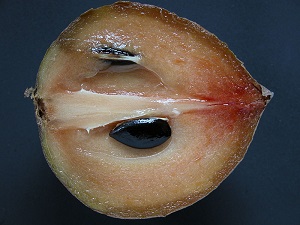From Julia
Morton's book Fruits of Warm Climates
and the University of Florida
Sapodilla
Varieties
In Florida, seedling selections of high quality have been named and
vegetatively reproduced. The first of these was 'Russell' from
Islamorada in the Florida Keys, named and propagated by R.H.
Fitzpatrick. It is nearly round, up to 4 in (10 cm) in diameter and
length, brown-scurfy with gray patches, and luscious, reddish flesh. It
is not a dependable bearer.
The second, 'Prolific', a seedling
grown at the Agricultural Research and Education Center, Homestead, and
released in 1941, is round-conical, 2 1/2 to 3 1/2 in (6.25-9 cm) long
and broad, with smooth, pinkish-tan flesh. The skin is lighter than
that of the 'Russell' and tends to lose much of the scurf as it ripens.
The tree bears early, consistently and heavily. Of later selection,
'Modello' is a good quality fruit but not a heavy producer; 'Seedless'
yields poorly; 'Brown Sugar' is a good, regular, high yielder; handles
and keeps well.
Some introduced cultivars being tested in
Florida include: 'Boetzberg', 'Larsen', 'Morning Star', 'Jamaica 8',
and 'Jamaica 10'. 'Tikal', a recent seedling selection, seems very
promising. It is light-brown, elliptic to conical, much smaller than
'Prolific', but of excellent flavor and comes into season very early.
Several cultivars not recommended because of low yield in southern
Florida are 'Addley', 'Adelaide', 'Big Pine Key', 'Black', 'Jamaica No.
4', 'Jamaica No. 5', 'Martin' and 'Saunders'. 1
Sapodilla
Cultivars for Florida 2
| Cultivar name |
Country of origin |
Fruit shape and
skin color |
Fruit size1 |
Pulp color and
texture |
Quality |
CFF rating2 |
Yield3 |
Season |
| Alano |
United
States (Hawaii) |
conical
to round, skin light brown, smooth |
S
to M, 115-250 g
(4-9 oz) |
smooth
to slightly granular |
very
good to excellent |
U
|
G |
Nov.-June |
| Betawi |
Indonesia |
conical |
ML,
140-315 g (5-11 oz) |
light
amber - yellow, slightly granular |
very
good, juicy |
U |
G |
late
Dec. |
| Brown
Sugar |
United
States |
round
to ovate, skin light brown, moderately scurfy |
S
to M, 133-170 g (4.6-6.0 oz) |
brown,
slightly granular |
very
good |
M |
G
to VG |
May-Sept. |
| Gonzalez |
Philippines |
round
to oval, skin very light brown, slightly scurfy |
M,90-260
g (3.1-9.2 oz) |
light
brown to brown, smooth |
very
good to excellent |
U
|
VG |
Nov.-April
|
| Hasyá
|
Mexico |
oval
to slightly conical, skin light brown, moderately scurfy |
ML,
150-365 g (5-13 oz) |
brownish
red |
excellent |
U
|
G |
Nov.-June |
| Makok
(dwarf) tree |
Thailand |
conical,
skin light brown, slightly scurfy |
S,
30-140 g (1-5 oz) |
light
brown to slightly greenish- red, smooth |
very
good |
U |
VG |
May-Nov. |
| Modello |
United
States |
elliptic
to ovate, skin light brown, moderately scurfy |
M
to ML, 227-340 g (8-12 oz) |
whitish
to tan, smooth |
good |
L |
F |
Feb.-May |
| Molix |
Mexico |
oval |
M
to M-L, 150-360 g (5-13 oz) |
brownish
red, smooth |
very
good to excellent |
U
|
VG |
Feb.-April
|
| Morena |
Mexico |
oval |
M
to ML, 170-345 g (6-12 oz) |
brownish
red, smooth |
very
good to excellent |
U |
G
to VG |
Feb.-April |
| Oxkutzcab
(Ox) |
Mexico |
roundish |
L
to very L, up to 800 g (1 lb, 12 oz) |
reddish
brown |
very
good |
U |
VG
|
May-Sept. |
| Prolific |
United
States |
round
to conical, ovate, skin light brown, slightly scurfy |
M,
170-225 g (6.0-7.9 oz) |
light
tan to reddish tan and smooth |
very
good |
H |
VG |
May-Sept
|
| Russell
|
United
States |
round
to conical to ovate, skin brown with grayish-brown patches, scurfy |
L,
284--454 g (10-16 oz) |
pinkish
tan, granular |
good,
mildly fragrant |
H |
P |
May-Sept. |
| Tikal |
United
States |
ellipsoid
to conical, skin light brown, slightly scurfy |
S
to ML 80-323 g (3-11 oz) |
light
brown, smooth |
very
good, fragrant |
L |
VG |
Main,
Dec. - March; minor, May-Sept. |
1, S=small;
M=medium; ML=medium-large; L=large.
2,
CFF, Caribbean fruit fly rating; L=low potential for infestation;
M=moderate potential for infestation; H=high potential for infestation;
U=unknown potential for infestation not known.
3, Yield rating; P, poor; F, fair; G, good; VG, very good.
|
 |  | Fig. 1 
'Hasya' sapodilla | Fig. 2 
'Hasya' sapodilla |
Back to
Sapodilla Page
|
|
Bibliography
1 Fruits of Warm Climates.
Julia F. Morton, Miami, 1987.
2 Crane, Jonathan H., et al. "Sapodilla Growing in the Florida Home
Landscape." Horticultural
Sciences Department, UF/IFAS Extension, HS-1, Original Pub. May 1973, Revised Apr. 1994, Nov. 2016, Nov. 2000, Oct. 2005, and
Oct. 2008, Reviewed Dec. 2019, EDIS, edis.ifas.ufl.edu. Accessed 4 July 2017, 13 Apr. 2020.
Photographs
Fig. 1,2 Asit K. Ghosh Thaumaturgist. "A whole and half of a ripe Hasya sapodilla (Manilkara zapota/Sapotaceae) from Fruit and Spice Park, Homestead, Florida." Wikimedia Commons, 25 June 2005, (CC BY-SA 3.0), GFDL, commons.wikimedia.org/wiki/Category:Sapodilla#/media/File:Sapodilla_Hasya03_F&SPark_Asit.jpg. Accessed 28 Apr. 2016.
Published 28 Apr. 2016 LR. Last update 13 Apr. 2020 LR
|


